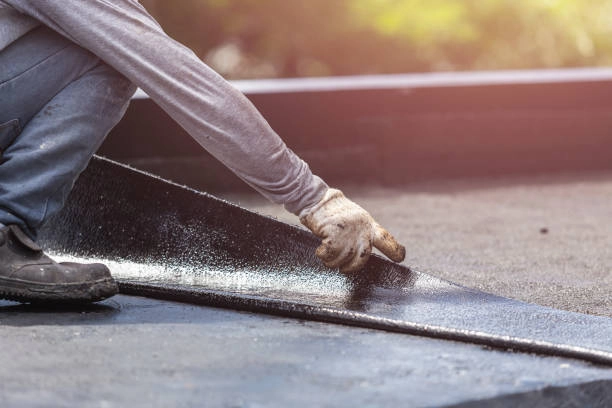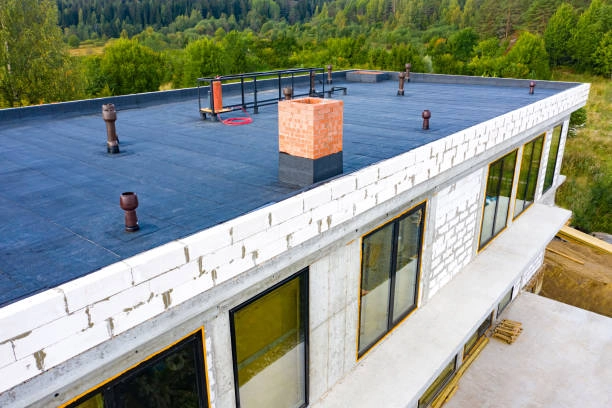Flat roofs are a popular choice for both residential and commercial buildings due to their modern design, cost-effectiveness, and versatility. However, flat roof installation can sometimes fail, leading to costly repairs and replacements. Understanding the common reasons behind these failures—and how to avoid them—can save you time, money, and frustration. This article explores the key pitfalls of roof installation and provides actionable solutions to ensure your roofing system performs reliably for years to come.

Common Reasons Flat Roof Installation Fail
1. Inadequate Slope
Flat roofs are not entirely flat—they require a slight slope (usually 1/4 inch per foot) to allow water to drain properly. When the slope is insufficient or improperly designed, water can pool on the roof’s surface, leading to leaks, structural damage, and premature deterioration.
How to Avoid It:
- Ensure the roof design incorporates a proper slope toward drainage points.
- Use tapered insulation during installation to create an effective slope.
- Work with experienced professionals like Gleason Roofing, who understand the importance of slope in flat roofing systems.
2. Poor Drainage Solutions
Flat roofs rely heavily on efficient drainage systems such as scuppers, gutters, and internal drains. If these systems are improperly installed or insufficiently maintained, water can accumulate on the roof, increasing the risk of leaks and structural issues.
How to Avoid It:
- Install high-quality drainage systems at low points on the roof.
- Regularly inspect and clean gutters, scuppers, and drains to prevent blockages.
- Consider adding overflow drains as a backup in areas prone to heavy rainfall.
3. Incorrect Choice of Flat Roofing Material
Selecting the wrong flat roofing material can compromise the durability and performance of your roof. Factors such as climate, UV exposure, foot traffic, and maintenance requirements must be considered when choosing materials.
How to Avoid It:
- Evaluate your building’s specific needs before selecting materials.
- Opt for durable options like EPDM (rubber membrane), TPO (thermoplastic polyolefin), or PVC (polyvinyl chloride), depending on your climate and usage.
- Consult with professionals like Gleason Roofing for guidance on choosing the best flat roofing material for your property.
4. Improper Waterproofing
Waterproofing is critical for flat roofs due to their vulnerability to water infiltration. Using inferior waterproofing membranes or failing to install them correctly can lead to leaks, mold growth, and damage to the building’s interior.
How to Avoid It:
- Use high-quality waterproofing membranes designed for flat roofs.
- Ensure proper installation by skilled professionals who understand waterproofing techniques.
- Inspect the waterproofing layer regularly for signs of wear or damage.

5. Insufficient Insulation
Flat roofs are prone to heat loss and gain due to their design. Without adequate insulation, energy efficiency suffers, leading to higher heating and cooling costs. Poor insulation can also cause condensation issues within the building envelope.
How to Avoid It:
- Choose insulation materials that provide thermal resistance suitable for your climate.
- Install insulation layers during construction or retrofitting projects.
- Consider energy-efficient options like rigid foam boards or spray polyurethane foam (SPF).
6. Ignoring Building Codes
Failure to comply with local building codes can result in safety hazards, fines, project delays, or even complete roof failure. Building codes often address critical aspects such as fire resistance, wind uplift resistance, and structural integrity.
How to Avoid It:
- Work with licensed roofing contractors who are familiar with local regulations.
- Ensure all materials and installation methods meet code requirements.
- Schedule inspections during construction phases to verify compliance.
7. Overlooking Thermal Movement
Flat roofs experience thermal expansion and contraction due to daily temperature changes. If this movement is not accounted for during installation, it can cause materials to warp, crack, or separate over time.
How to Avoid It:
- Use flexible materials that can withstand thermal movement without damage.
- Incorporate expansion joints into the design where necessary.
- Regularly inspect the roof for signs of cracking or separation.
8. Poor Deck Structure
The roof deck serves as the foundation of your flat roofing system. If it is weak or improperly constructed, it can compromise the entire roof’s stability and performance.
How to Avoid It:
- Ensure that the deck is structurally sound and capable of supporting expected loads (e.g., snow accumulation or rooftop equipment).
- Use high-quality decking materials, such as plywood or concrete panels.
- Avoid cutting corners during construction—invest in a strong foundation.
How Gleason Roofing Ensures Successful Flat Roof Installation
At Gleason Roofing, we understand that every detail matters when it comes to flat roof installation. With over 50 years of collective experience in Phoenix’s unique climate challenges, we prioritize quality craftsmanship and long-lasting results in every project we undertake.
Here’s how we help you avoid common pitfalls:
- Expert Design: We carefully plan every aspect of your flat roof installation—from slope calculations to drainage placement—to ensure optimal performance.
- High-Quality Materials: We use only top-grade flat roofing materials that are durable enough to withstand Arizona’s intense heat and UV exposure.
- Code Compliance: Our team is fully licensed and insured, ensuring all installations meet local building codes for safety and reliability.
- Regular Inspections: We offer maintenance services that include inspections for potential issues such as ponding water or material wear.
- Customer Satisfaction: With an A+ rating from the Better Business Bureau, we’re committed to exceeding expectations in workmanship and service.
Preventative Tips for Long-Term Success
To maximize the lifespan of your flat roofing system:
- Schedule regular inspections by professional contractors like Gleason Roofing.
- Clean gutters and drains at least twice a year, especially before rainy seasons.
- Address minor repairs promptly before they escalate into major problems.
- Ensure proper ventilation within your building envelope to prevent moisture buildup.
- Invest in high-quality materials during installation or replacement projects.

Flat roof installation fails primarily due to poor planning, substandard materials, or inadequate craftsmanship—but these issues are entirely avoidable with proper care and expertise. By understanding common pitfalls such as inadequate slope design or poor drainage systems—and taking proactive steps—you can ensure your flat roofing system remains durable and efficient for years.
Gleason Roofing is here to help you achieve success with your flat roofing projects in Phoenix, AZ. Whether you need assistance with installation, maintenance, or flat roof replacement services, our team has the expertise you need. Contact us today for reliable solutions tailored specifically for your property!
Frequently Asked Questions
1. What causes roof installation failures?
Flat roof installation can fail for a few reasons. One reason is not having the right slope. Another is having bad drainage systems. Choosing the wrong roof material is also an issue. Not waterproofing it correctly can lead to problems, too. Ignoring building rules is important to avoid. Also, movement due to heat and a weak deck can make it less stable. Working with experts helps you get a good design and strong flat roof performance.
2. Why is slope important in flat roof installation?
A slight slope (about 1/4 inch per foot) in roof installation helps water flow toward drainage points. Without it, water can pool, causing leaks and structural damage. Using tapered insulation during installation ensures adequate slope, helping maintain efficient drainage and protecting the flat roofing material from premature deterioration.
3. How does bad drainage impact flat roof installation?
Poor drainage in a flat roof setup can cause water to gather. This can damage the flat roof and may lead to leaks. To prevent this, put in good flat roof drains, scuppers, and gutters where water collects. Regular care and adding overflow drains can help keep water flowing well and protect the roof.
4. What is the best flat roof product for lasting use?
Choosing the right flat roofing material for installation is important for lasting use. Options such as EPDM, TPO, and PVC offer good weather protection. Think about factors like climate, sun exposure, and care needed when picking materials. Talking to experts helps make sure the chosen material fits your building’s needs and lasts a long time.
5. How can improper waterproofing affect flat roof installation?
Bad waterproofing in roof installation can let water in, causing leaks and damage inside. It is important to use good waterproof materials and have a professional install them. Regular checks can help spot any wear and tear, so repairs can be done quickly. This keeps the roof working well and protects the inside of the building from water damage.
6. Why is insulation important in flat roof installation?
Good insulation when putting on a flat roof makes energy use better and cuts down on heat loss or gain. Using things like rigid foam boards or spray foam helps keep indoor temperatures steady. Also, insulation lowers the chance of moisture build-up. This helps protect both the flat roof and the building from moisture problems.
7. How can thermal movement damage flat roof installation?
Thermal movement in roof installation causes expansion and contraction, which can damage roofing materials if not managed properly. Using flexible materials and adding expansion joints during installation help accommodate temperature changes. Regular inspections help identify issues like cracks or separation, maintaining the flat roofing system’s durability.
